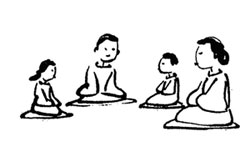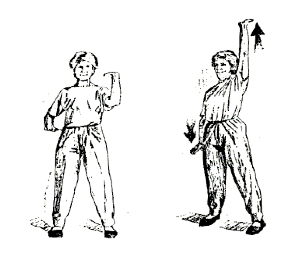Pre-lesson notes
I’m so alive before the session. Acute magnification of senses. I do walking meditation as I prepare.
Along comes the stream of questions
90 minutes! Such a long stretch of time. Should I plan more? Photocopy brain diagrams?
Will the pupils be utterly drained after having had a 2 hour English exam? Should I bring in incense? (no, fire code) food? (the raisin meditation) free-form artwork? (a little art therapy, maybe…)
I know the power of good basic Safat Hakeshev (Language of Attentiveness) core techniques, so I remain confident in my lesson plan and reconnect to my body in the present moment.
Note: A good basic meditative body scan serves to ground any flying, loose energies. Plus, no problem, since all those mattresses from last June’s workshop are still in the Relaxation room (at least as of last week). Pupils will be pleased.
Notes after the lesson:
Going early to prepare the room, I aired it out and arranged the sitting circle. But…lo and behold, no mattresses were in sight. Someone, sometime during the previous week, had reclaimed and removed them. So, the meditation in prone position was unmattressed but rather conducted on the long puffy poufs in the room. A few kids built their own combinations of smaller poufs. All was fine.
When I went to the 8th Grade building to collect my students and bring them to our space, there, amongst them, was A, a student who had indicated that he truly didn’t want to be in this workshop. “Why are you here, A?” I asked.
“There’s nothing else,” he said. “There’s no other course.”
I was incredulous. “What about photography? Surely that would be an option.”
“They don’t really do photography there,” I was informed. “They learn how to do digital effects on images.”
Sinking hearts all round – I wondered who made these kind of decisions.
We arrived at our room. Shoes off, phones off, backpacks parked, and on to a pouf in the sitting circle. I reminded them to maintain silence and get comfortable. That, clearly, wasn’t easy for them! Two decided to fight for what I had claimed as my place. With a burst of innovation, they rearranged the poufs to make room for everyone to sit comfortably.
I announced the plan for the day: we would engage in a few forms of meditation – lying down, sitting and standing – with some t’ai chi. There’d be opportunities to speak or share their reactions and ask questions. Their assignment was to work on themselves and to show respect for others.
I invited them to set aside all that happened before or what might happen later. I offered them the wonderful opportunity to have this time to simply be present.
Noticing our Breathing
I reiterated how we can use our breathing as an anchor for being present in our bodies. By paying attention to our breathing, we can find something to anchor us in the present moment.
Two-minute breathing exercise. Sitting upright, we noticed our feet on the floor, our bodies on the pouf, and we straightened our spines. Our task was to notice our breaths. I invited them to count 10 breaths by using their fingers. When they reached 10, to begin again.
Me: “First release all air until your bellies are empty. Then inhale, exhale: 1. Inhale, exhale:2. And to continue in a rhythm that is comfortable for you.”
(Mid-process, there was a surge of voices coming from the lobby of the 9th grade building.)
After 2 minutes: Gong!
Me: “How was it? Did anyone lose count due to random thoughts? Had the outside noise interfered?”
No one indicated any difficulty.
Question from N: “I want to know how I’m supposed to listen to just one thing when something else bothers me. Like during my test. I had to listen to the voice on the MP3 reading the text, but the teacher was right beside me, talking loudly. I couldn’t hear. How am I supposed to focus?”
Me: “Good question. How can I focus on one sound when there are other sounds around. Hmm.”
Being mindful of sound
Me: “Let’s try an experiment. I’m going to ring the Tibetan Singing Bowl and invite you to raise your finger the moment you stop hearing the sound.
Even though there might be other sounds in the room or outside, we will listen to only the Singing Bowl. When you stop hearing it, raise one finger. Ready?”
Gong !

Tibetan Singing Bowl
It didn’t take long. Fingers went up.
J: “I’m not sure if I really heard it or if I just thought I heard it. Let’s try it again.”
M: “It was hard for me to really hear it because of the air conditioning unit on the wall above me.”
Me: “Okay. We’ll do it again. This time, I’ll move around the circle. Close your eyes and just listen. Ready?”
Gong!
This time, I slowly moved around the room as I made a continual circular sound with the mallet. Eventually I stopped and waited for their finger responses.
One boy didn’t raise his finger.
N: “Hey, J! Did you fall asleep?”
J: ““It’s okay, N! I’m awake!”
N: “One more time.”
We did it again and this time 2 students continued to hear the bowl, long after it stopped vibrating.
“Okay! Interesting. This is one way we can practice focusing on one specific sound.
Now we’re going to move to the next phase: meditation while lying down. In a minute I’ll give a signal. You’ll take your poufs and arrange them in a circle on the floor, heads to the centre, feet to the wall. I’ll be in the middle. You’ll lie on your backs. Ready? On the gong!”
Gong
-
Body Scan Meditation*
*The body scan meditation provides a wonderful base to ground the body, relax and focus on the physical forms.
Body Scan – They settled down and I instructed them to simply acknowledge their bodies on the mattress.What was the sensation? How did it feel to do nothing but lie down with the mattress supporting them?
We began our scan noticing our heels and feet and part by part, we travelled up along the body. I kept to a steady, easy-going rhythm. I knew that these kids were not the adults I’d been guiding through body scans, and the speed would have to be adjusted. I planned to observe very carefully as I led them. Would they want to linger or hurry on? Would they fidget and want to speak?
I walked between them, conscious of my feet on the ground, the sound of my voice while watching them. I kept an eye on my watch to check the timing.
Some kids were adjusting their bodies, but they were with me. The scan took about 15 minutes. I invited them to observe if there was any part of their body that hurt, and if so, to place hands there. Some changed their hand position.
After a few minutes, I invited them to place their palms on their bellies, and observe the rising and fall along with the intake and exhalation of air.
Hands at their sides again, I asked them to notice if there was any change in body sensation: more relaxed, cold, warm. To notice.

from wikiHow
We began our transition towards sitting up.
“In a few minutes I’ll invite you to slowly roll onto your sides.”
Gong! On the signal they did so. I was silent.
“Our next phase will be to sit up and by the end of 4 counts, be sitting.
Ready? 1 – 2- 3 – 4- (are you almost sitting?) 5!”
Movement while Sitting
We began our session by noticing our feet on the floor. Our bodies on the pouf. We made one small adjustment as if a magnet was pulling us up towards the ceiling, our shoulders relaxed and we exhaled. Our hands were in our laps or on our knees. And we counted our breaths.
Then we did some movements, noticing our breaths while we did.
We started off easily.
Upper body twist: two hands planted at our sides, we twisted gently looking over our shoulders, focusing on what we saw and then circled round to the other side.
Facing forward: Limb stretches. We picked up the rhythm.
Raised a leg, put it down. Other leg, put it down.
We raised one arm, put it down. The other arm, put it down.
We raised a leg, same side arm, put them down. Other side: leg and arm, down.
Then we did opposing limbs: Right leg up, left arm up. Down. Left leg up, right arm up. Down!
We did the same series, only using 45 degree angles.
Then we raised both arms, put them down. Both legs, put them down. Then both arms and both legs! We held it. Down.
Then both arms out at an angle + both legs out at an angle. Held it! Down!
Cooling down. We took large breaths, circling our arms up above our heads and then down with the exhale.
Then we shook out our hands, arms. Shook out our legs. And sat very still.
How was it? Had they noticed their breaths?
What did they feel in their bodies? Were they warm or cold?
N: I feel relaxed
M: (nodded)
Break before our Standing Session.
M fished out her water bottle from her backpack. She couldn’t open the cap. “It’s impossible,” she said.
Me: “You’re too relaxed” and I opened it for her (It helps to add a little faith to any task that seems daunting).
Back again.
Standing Meditation using movement
I invited them to stand in a circle and re-connect to the present moment.
I guided them through a search to find their balance. Then we began a T’ai Chi warm-up through the parts of the body. By the time we’d warmed up, they were tired.
I decided to bring them the good news that we’d be doing something new, that allowed them to sit or lie down, however they felt most comfortable.
Metta meditation
I introduced the Metta meditation.*
*Metta (lovingkindness in Pali) is a meditation based on the repetition of phrases such as “May I be safe, be happy, be healthy, live with ease” (as suggested by Sharon Salzberg). The repetition is done in a rhythm that feels right, with spacing that feels appropriate. These phrases and their repetition provide an anchor of our being in the present moment while opening our hearts.
They deserved attention. They’d worked hard that day. Here was a chance to offer themselves compassion, kindness, love and attention.
I led them through 3 phases: To offer lovingkindess to themselves, to someone who inspired them and to someone who might be going through a hard time.**
**Since I don’t know their personal histories, I wasn’t sure that this was a good idea, but I thought that with open hearts feeling kindness towards someone else might be important.
At the end, I asked them to return their thoughts to themselves, offering lovingkindness and ending with a self-hug. “There’s no one like me!”
As I hugged myself, I guided them: At the end of the meditation, I suggested that maybe through the coming days, they might open their hearts and really offer attention to someone who might speak to them, or to notice when they themselves needed some love.
This lesson took place just before Yom Kippur. As this is the time in the Jewish calendar when one asks for forgiveness for something done intentionally or inadvertently, I thought that this meditation might be helpful. I was hoping this wonderful tool might be useful to help them through what might lie ahead.
Transition towards our lesson’s end. Slowly rolling onto their sides, we moved to sitting position, and then to standing. I invited them to take a place around the table and in their notebooks, simply record something that they’d noticed or experienced during the lesson. They could write or draw.
Journals
They each took their journal. All but A.
A: “I don’t write.”
Me: “Even your name?”
A: “Nope!”
A was the one who hadn’t wanted to be there, but was. Since the atmosphere of the room is an element that teaches just as much as any words on my part, there was benefit in letting him be. I was hoping that whatever he got out of these sessions would be visceral, tactile.
N drew a picture.
Me: “Would anyone like to share?”
N: “You don’t want to see this.”
Me: “Sure I do!”
He showed me a face with a huge circular orifice.
A: “Angry birds? You drew angry birds?”
Me: “A, please…”
N: “No. It’s not Angry Birds. It’s me. I wanted to kind of dissolve, flow. …”
Me: “Wow! And what can you tell me about this?” (I looked at the other side of the page and saw a huge pipe and a container of something).
N: “This is me trying to soak up the yoga.”
I was impressed. I got his permission to write down what he said so that I could reference his words as we continued.
I thanked them very much for coming and wished them all a good week.
They put on their shoes and left. I opened their journals. M said that N was a good artist! And that she really liked the relaxation session, lying down.
J said that he had experienced relaxation and that it felt so good.
How does a teacher know if the lesson was good? Feedback helps. Their attitude helps. With a quick self-inventory, I, too, felt good. As Simi says, it’s the presence of the instructor that contributes most to the effectiveness of the lesson.
Always good advice. No matter when or where.
Teaching Safat Hakeshev, the Language of Attentiveness, offers a chance for study at so many levels. And every lesson touches another node of enquiry.
Till next time.



















